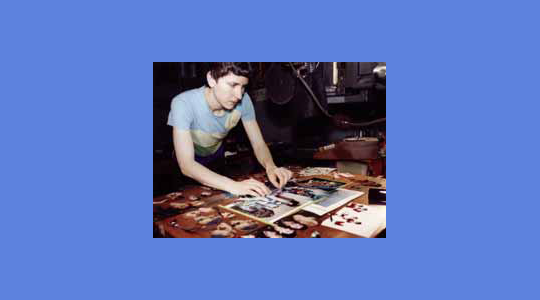Alumna Spotlight: Shawn Atkins ’92
In April, filmmaker Shawn Atkins was named a 2007 Guggenheim Fellow; the fellowship will support her work on The Broken Teacup, an adaptation of some of Franz Kafka’s short stories. Atkins also runs The House of Frame by Frame Fierce, Inc., a nonprofit organization dedicated to using animation as a form of artistic activism for at-risk youth.

Why are you drawn to animation as your mode of expression?
Animation is an amazingly elastic and generous medium, which awakens the landscape of my imagination, my dreams, and ultimately, my unconscious. In the creation of this landscape, animation doesn't limit me to a single art form. With animation, I can combine photos with paintings and drawings to tell stories, which teeter between real and imaginary worlds. In many of my films, the characters start out in the “real” world, and are quickly catapulted into a magic, imaginary world by the events of the narrative. Similar to fairy tales, the characters in my films must find their way back into the real, undergoing various challenges along the way which help them evolve and transform.
Do you have a typical method by which you work, or do you adapt to the project?
The germination of my films has been a strange, dreamlike process. Captivated by an image or a sequence of images, I will begin to work. This work takes multiple forms: research and writing, storyboarding, and simultaneously, the creation of images, whether characters or backgrounds. Although the films I've made are very different from one another, each film extends a thread which surfaced during the making of the previous films. While making my second film, The Travelling Eye of the Blue Cat, I studied C.G. Jung’s writings on the unconscious. One of Jung’s characters in that film was a little monster—half Frankenstein, half Chaplin—that emerged from the main character’s head in an effort to help her resolve the narrative. Jung wrote extensively on the internal division between the conscious and the unconscious psyche of individuals: how at a certain level people remain unknown to themselves and that this lifelong struggle to understand oneself births self-awareness. Jung's writings helped me develop the character of the psyche in my blue cat film. However, Jung’s influence didn't stop; his idea of a precarious balancing act between the known and unknown within the individual became the starting point for my Kafka project. At its foundation, this new project is an effort to understand how conflict is generated within an individual and what happens if this conflict is projected outward, rather than dealt with internally.
Although Travelling Eye is surrealistic, there are some autobiographical touches. Are you approaching the Kafka adaptations differently?
My films have all started out from an autobiographical point. The Travelling Eye began as an animated documentary about my two very jealous and mischievous cats. From there, the film traveled into the realm of the imaginary, allowing me to explore a story of transformation—what Jung termed individuation, the evolving self-awareness of an individual. The two destructive cats became helpers in the journey of the main character. I conceived the Kafka project in 2001 after the destruction of the World Trade Center, as an attempt to understand where the impulse for war originates in the human psyche. The stories I am adapting revolve around a character's interior struggle to grasp something that lies beyond one's comprehension, and the internal conflict that this incomprehension creates. Interestingly enough, Kafka wrote these particular stories during a period of great political turmoil and destruction—World War I. Based on my own experiences during Sept. 11, 2001, I understand them within a context of war and conflict, as the response of an artist to exterior destruction and nationalistic hatred.
How did you get started making films?
I grew up in a household devoted to film and theatre, immersed in the fantastical worlds artists could create through their imaginations. I played backstage in the university theatres where my parents taught, and was often onstage in children's roles. As early as I can remember, my parents encouraged me to express myself creatively. I, however, didn't start to make films until graduate school. In high school and college, I wrote poetry and edited a literary magazine. When I moved to New York, I reached an impasse with written language and no longer felt able to express my experiences in words. At that point, I began to experiment with photography and painting. In graduate school, I took an animation class and realized that animation allowed me to combine photography and painting to create a type of visual poetry. I've been working in this medium ever since.
What’s the most important thing you took away from your time at GS?
GS gave me so many important experiences; it’s a challenge to pinpoint just one. Professor Ivan Sander's classes in Eastern and Central European literature showed me how art and politics intertwine to create absurd worlds which communicate in hermetic, hilarious, and oblique images. Professor Luciano Rebay's Italian poetry classes imbued me with a deep respect and love for the creation of stark and powerful poetic images. Also, the friends I made at GS later became my most important working colleagues. Nita T. Brown ’93 helped me produce The Travelling Eye of the Blue Cat and later became one of the founding members of The House of Frame by Frame Fierce, Inc.
How has teaching affected your work?
In recent years, I've taught animation to children between the ages of five and nine. They have shown me repeatedly how powerful the impulse can be to express one's inner world through images. Their films literally burst with colors and strange, otherworldly characters. The children have a joy and fearlessness in creation, which I often draw upon in my own work.
